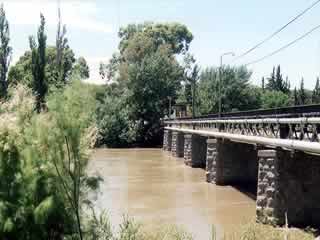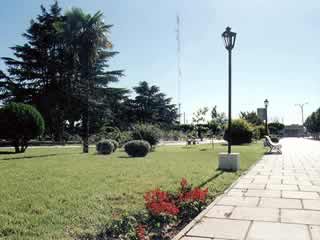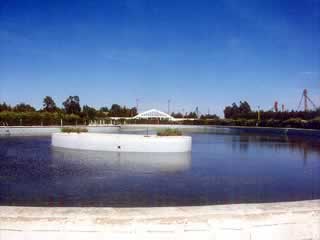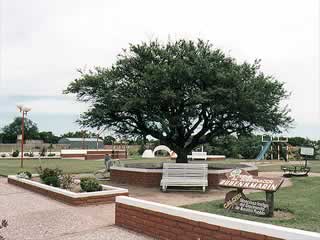|
Editor's note: It is not included
the entirety of the towns and cities of La Pampa
• Caleufú
and Trenel, Towns of Wood: the route that opens in
the west of National Route 35, next to Trenel, has been -till
recent times- a dusty way, and some tracks were feared by
vans and trucks. That line was the natural exit of many great
woodcutter groups present in La Pampa fifty years ago. Going
to the border with San Luis province, you can still see some
findings and the majestic forestland; this is the best area
for caldén. It is precisely there (Caleufú,
30km from route 35), in one of these “towns of wood”,
where you can still see one of the most ancient trees of Argentina:
the giant caldén El Recado, called after the name of
the place in which it is located.Comparable -in its magnitude-
to “Carobe Grandfather”, the character of a song
that Antonio Esteban Agüero would sing in San Luis, this
many times centennial or, may be, millenary tree stands dominating
what was, in times of Desert War, the most important and mysterious
place: the lagoon of Trenel. Formerly, Colonel Manuel Baigorria
lived in this area of Ranquelinos. Today, with a past plenty
of legends, this impressing vegetal monument is an example
of strength and life in its most beautiful and useful ways.
• Carro Quemado
and a visit to the past: the locality of Carro Quemado,
125km from Santa Rosa, possesses a whole “heritage from
the past”. In the midst of a little, plain and wild town,
surrounded by a country landscape, nature and history live
together. There those who visit the farm “ La Marianita”
-besides its excellent touristic service- will find pieces
of the pampean archeology, gaucho silvery, collections of
antique bottles, replicas of aboriginal pottery and an Artisanal
Workshop, where you will find the rescue of America’s
art and the value of the Pampa art. Undoubtedly, the past
is never as present as when you tour the Orgales Family Museum;
yesterday, the first grocery’s in the town and today,
a general store, a store of memories. This museum is a true
treasure that gathers data and curiosities of a past full
of experiences, in which you will find the remains of the
mythical “Carro” from which the town takes its name:
“Carro Quemado (burned truck)”. To know it is to
be partaker of the past of La Pampa and it deserves to be
visited by whoever loves the province.
• Colonia Barón
and The Temple of Colonia San José: "the
Temple of Colonia San José -whose historic plaque shows
that it was founded on April 21, 1929- was declared Provincial
Historic Monument on August 12, 1983. Located in the Colonia
San José, a rural area of Colonia Barón, the
temple has unique historic features and is the most important
religious center in the pampean north, and one of the most
relevant in the whole province. Today you can visit it in
order to admire its richness and contemplate the images and
the inner beautiness of an amazing architecture.
Very near, in Colonia Barón, the communal seat of the
area, an important camping and a swimming pool are waiting
for the visitor.
• Doblas and
the "Expo Apícola". This little but
industrious location, situated a few kilometers from Santa
Rosa, started promoting and trading honey almost a decade
ago and has presently reached significant production levels.
Since 1993, the “Expo Apícola Doblas” has
been held in that location and it is one of the most important
commercial and industrial fair in the country regarding this
activity, in which every year (in August) the most important
producers, exhibitors and speakers meet.
• Eduardo
Castex and the feast of wheat: alhough in all the towns
of La Pampa the presence of settlers is a constant, maybe
in none of them this circumstances and its consequences is
as clear cut as in the case of Eduardo Castex. The locality
is on National Route 35 and halfway between Realicó
and Santa Rosa. Once a year, this place -located at a strip
of the pampean forestland doors- pays homage to those pioneers
and their descendants by celebrating during the last week
of January the Provincial Feast of wheat. This feast became
an important sociocultural event in a huge area.
• General
San Martín and the Salt Feast: Villa Alba was
founded on August 16, 1901. This name was changed for General
San Martín in 1944. It is located in Hucal district,
next to National Route 35, which connects Santa Rosa with
Bahía Blanca. Since its foundation, Agriculture, specifically
the production of wheat, has been fundamental for the economic
development of this locality. Also important is the production
of the still active salt mine “La Colorada Grande”.
Every year, in November, General San Martín celebrates
the Feast of Salt.
• Ingeniero
Luiggi and its feasts: Ingeniero Luiggi was founded
in 1910. It is located in the west of the humid pampa and
within it, where the railways start, next to the occidental
limit with Realicó district. The soil is plain, with
slight undulations, and up to that points it presents the
best climate and soil conditions for farming activities. The
town was born with 139 blocks and the present design, with
4 diagonals that converge towards the central square. Italian
engineer Luis Luiggi (1856-1931), who also built the Navy
Base Punta Alta, prepared the drawings. The Horse Pampean
Feast, held in January, made famous the town; at present,
is the classic selection for the National Folklore Feast of
“Cosquín” in Córdoba province. Luiggi
was always popular due to the dancing parties and meetings
that gathered people of a huge area, even the neighbor province
of San Luis.
• Intendente
Alvear and the National Festival: currently, La Pampa
has the best polo of the world, or the best polo players,
which is quite the same. If you want to see it, you have to
travel up to the polo club of Chapaleufú located in
the centennial northern locality of Intendente Alvear. There,
they say, “they will never know if they have the best
horses because they have the best polo players or if they
have the best players because, at the same time, they have
the best short horse trainers and tamers...”. To reassure
its soul of old criollo town, once a year Alvear vibrates
with other folk manifestations. During the last week of January
and February, the National Festival of Taming and Folklore
takes place. For some days the best horsemen of Argentina
and bordering countries and the best voices and guitars move
under the aged trees of Alvear and for one night they show
their skills on stage or in the brake-in field.
• La Adela
and Anzoátegui large salt mines: “La Adela”
is a picturesque town located on National Route 154 and 22,
on the left margin of Colorado River, the provincial limit
between La Pampa and Río Negro. La Adela little town
was founded on August 26, 1909, and has the name of a shop
of late last century, with which the place was identified.
A close communication with (the river between) Río
Colorado city sets the stage for an important service offer
in the area: hotel and restaurants. Many touristic projects
related to the river are underway. Although the area is chiefly
suitable for cattle breeding, with an important cold packing
plant installed, it offers grains like wheat, tomatoes plantations
and fruits, coupled with salt production.
• Macachín
and Hidalgo large salt mines: it is the seat of the
principal Basque community of the province, and one of the
most important of the country. It has important hotels and
recreational and sportive facilities that provide the tourist
with the ideal rest. Historically, it shares with General
San Martín and Anzoátegui the principal production
and exploitation of salt.
• Miguel Riglos
and the "Expo": Miguel Riglos, which belongs
to the Atreucó district, is located next to one of
the railroads that enter into La Pampa, and the southeast
of the cross between Provincial Routes 1 and 14. The foundation
date is November 11, 1911. In early times, it can be underlined
the abundance of wool stock and the sheep shearing as a job
opportunity; but sheep decreased and cattle prevailed. Among
cereals the most important is wheat. Large stores gradually
turned into specific shops for determined sectors. At present
times, the municipality has developed a Disposal Plant, which
is a good example of the economic progress of the province.
«Expo Riglos» is a farm and trade show held annually,
and every year it increases the number of attendees.
• Miguel Cané:
Miguel Cané, located less than 15km from Buenos Aires
Province and provincial route Nº1 was founded in 1908
.
This vigorous locality belongs to Quemú Quemú
district and had his first communal organization in 1919;
now it became a municipality. Farming activity constitutes
the main income source; Dairy production should be underlined
due to its significant industry located in the same locality.
Also, there is an important plant for dairy production in
a rural area.
• Pichi Huinca
and the Recreational Area: although this area in the
south of Rancul district is located in a forestland of La
Pampa, agriculture is the principal activity. The beginning
of this community is connected with the arrival of settlers,
who in the first years did not constitute a locality itself
but a farming colony. Through the years, Pichi Huinca has
been building the necessary structure for its advance, showing
the energy that identifies it. The police station, the mail
office, the civil registry and the magistrate’s court
are buildings of old time. In late 1997, the locality inaugurated
an important complex comprising two swimming pools -one imitating
an artificial lake with falls of 6m- with water slides and
surrounded by a great woodland and a high cave in which you
will find the Virgin of the Miraculous Medal. There you can
also find fireplaces, tables, benches and a camping area.
• Quehué
and the "Big Hunting Feast". This location,
which defines itself as the “big hunting capital”,
is an excellent hunting area of approximately 120 thousand
hectares and has very important trophies on its records. The
Quehué Valley, presents one of the most attractive
geographical features of the province and provides space for
a modern farm and a meat processing plant engaged in the whole
husbandry of red deers, which are then exported or sent to
the main game reserves. Every year, approximately in October,
Quehué is the meeting place where hunting lovers coming
from every place in the country meet at the Big Game Provincial
Feast.
• Quetrequén
and its Recreational Park: the recreational park “San
Francisco de Asís de Quetrequén” was inaugurated
in 1909. Visitors may find individuals barbecues, games for
children, drinking water, light, restrooms, benches, sandy
grounds, an artificial lake with falls, a camping area, a
shed, etc. During the season, passersby and people from Quetrenquén
visit the place, which is one of all the examples of quiet
and ordered work of the provincial towns.
• Santa
Isabel and the "Goat's Provincial Feast".
At present Santa Isabel is one of the main junctions where
National Highways Nº 143 and 151, and the Provincial
Highway Nº 20 converge. This road laying predicts an
important development for this little town for the next years,
as some service companies have already started investing.
It is a breeding area par excellence, specially goats. This
is why every year, in December, the Goat’s Provincial
Feast, which is well known in the area, takes place in Santa
Isabel and attracts people from the west of La Pampa Province,
south of San Luis Province, and the region of Cuyo. Besides,
native people manufacture the best pampean handicrafts utilizing
aboriginal methods as some of them are descendant from the
former settlors.
• Winifreda
and the Cacique Pincén: the locality of Winifreda,
located on National Route 35 between Santa Rosa and Eduardo
Castex, where the pavement towards the pampean starts, is
remembered because of its former big production of hogs and
was always an important area for wheat cultivation. The indomitable
Cacique Pincén and his tribe lived in this place, in
which there are still reminiscences of their fights and adventures,
blended with other cultures and different immigrants among
which the Saxons, who settled this industrious area, should
be underlined. Today the locality grows under the protection
of its institutions, among which the domestic Electricity
Cooperative has recently opened a state-of-the-art hotel.
|

La Adela

Miguel Riglos

Colonia Barón

Trenel
|
<<
click here to Return to the previous page
|

